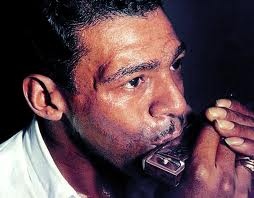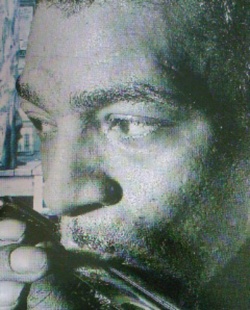The Little Walter Diary Ch.2 – Sad Hours
 Round about five
Round about five
Having openly declared my personal shortcomings apropos studying Walter Minor, there’s no escaping his genius. And the guy continues to toss pebbles at the window of my blues garret. The latest wake up call was a request to decode the start of Sad Hours. The outcome? Unexpected exposure to an architectural masterpiece. I was left standing in my pyjamas, rubbing my eyes, wondering what hit me.
It’s a given that mastery of Little Walter’s diatonic dialect is an essential step in any blues harp player’s development. Ever contrary by nature, I therefore embarked on a love affair with Big Walter. Latterly however, I have come to accept my latent appreciation of Marion Walters Jacobs and to indulge in the occasional flirtation. Sad Hours certainly gets the blues fuse smouldering. It was Walter’s 1952 follow up to Juke and it made No.2 on the Billboard R&B Chart.
 The start of the track is in some respects a disappointment. Don’t expect an instant harp fix. Little Walter lets the groove settle for the opening twelve bars – a 30 second wait – before piping up. Perhaps this illustrates a habit he cultivated; the delayed entry that afforded him time to check a piece over and prepare his plan of attack. On the other hand, perhaps he borrowed the structure straight from Pee Wee Crayton’s 1948 recording of Blues After Hours. The piece was a standard on bandstands at the time.
The start of the track is in some respects a disappointment. Don’t expect an instant harp fix. Little Walter lets the groove settle for the opening twelve bars – a 30 second wait – before piping up. Perhaps this illustrates a habit he cultivated; the delayed entry that afforded him time to check a piece over and prepare his plan of attack. On the other hand, perhaps he borrowed the structure straight from Pee Wee Crayton’s 1948 recording of Blues After Hours. The piece was a standard on bandstands at the time.
Either way the wait is worth it. His opening phrase is a clarion call to the blues, and only Little Walter could pull it off with one crucial detail. Playing a Bb harp in F, he relies on the micro-bend in 5D to proclaim his arrival with an iconic lick. Here it is at full speed, and again slowed down.
3D 4D ~5D…. 5D’..4D..4B..3D’..2D…. 1D 2D..2D”
No tabs can do justice to the phrasing and dynamics Walter uses in this extract, or the musical impact he delivers from the 5D’. The way he builds portamento into the 5D, then returns to the faux bend is wizardry. Any respectable harp teacher will point out that 5D’ is a quarter tone. It might even be suggested that 5D’ is an illegitimate note in western music. For blues power however, Little Walter kicks aside the no entry sign and teaches us that 5D’ can provide a slice of magic if used wisely. In effect he convinces us we’re hearing a note that doesn’t actually exist. Any blues harp apprentice should capture this phenomenon. It turns heads. How to tab it correctly remains a conundrum, so for now we’ll rely on a single apostrophe to indicate a bend per se, albeit a partial one.
After hours, when the joint is closed
 In the interests of research, let’s check out a few other features from the track that warrant review. Topping the list are Walter’s variety of textures, his economy of notes, and that world famous warble; the harp trademark that Muddy Waters loved so much. The net effect is a harp instrumental that focuses entirely on the groove, demonstrating that the song is always king.
In the interests of research, let’s check out a few other features from the track that warrant review. Topping the list are Walter’s variety of textures, his economy of notes, and that world famous warble; the harp trademark that Muddy Waters loved so much. The net effect is a harp instrumental that focuses entirely on the groove, demonstrating that the song is always king.
Walter’s only departure from this is when he plays underneath Louis Myers’ guitar break early in the track. It may have been easier on the ear to drop the harp out, adding fuel to the debate whether a blues harp player has license to accompany a vocal or lead part, instead of punctuating it. For some it’s all part and parcel of Walter’s style.
Picking out another iconic moment, there’s Walter’s agonised, grinding bend in a 3D” as the song passes from the I chord to the IV chord. It’s a winner that’s been adopted by countless harp slingers ever since.
At the tail end of the piece there’s also a set of surprise staccato triplets across 4 bars. This is a great device for building tension and it juxtaposes the more fluid phrases that precede it.
As well as Pee Wee Clayton’s Blues After Hours, a T-Bone Walker style guitar hit, it is documented that Little Walter will also have been influenced by After Hours, a jazz standard first recorded in 1940 by the Erskine Hawkins Big Band, written by Avery Parrish. Here’s a clip from the band’s piano part, which points to the grinding 3D” and later staccato patterns Walter deploys.
Then there’s the turnaround Walter uses 3D..4D..5B..3D 1D..1D..2B..2D..2D 1D 2D”..1D while hinting at the big band staple 3D..4D..4B 5B..6B..6B 2D”..2D”..1D
And finally Walter’s classic outro ends the piece on a sustained whole step bend in hole two 3D’ 3D” 2D 2D” 1D 1B 1D… 2D 2D’ 2D”
Time to spend a happy hour or two imbibing Walter’s creativity.


Thanks hugely for sharing. Love it. Especially your words on the creative contex of this creation by this great (and little) Walter. 🙂 Really encouraging me to study it too. Ever done a study on on one of his chromatic tunes? Very many thanks again. Nick
Hi Nick. Thanks for your feedback. A Little Walter chromatic? You’ve reminded me of something I’ve been meaning to explore for a few years. I just need to dig out a particular harmonica from the back of the cupboard…